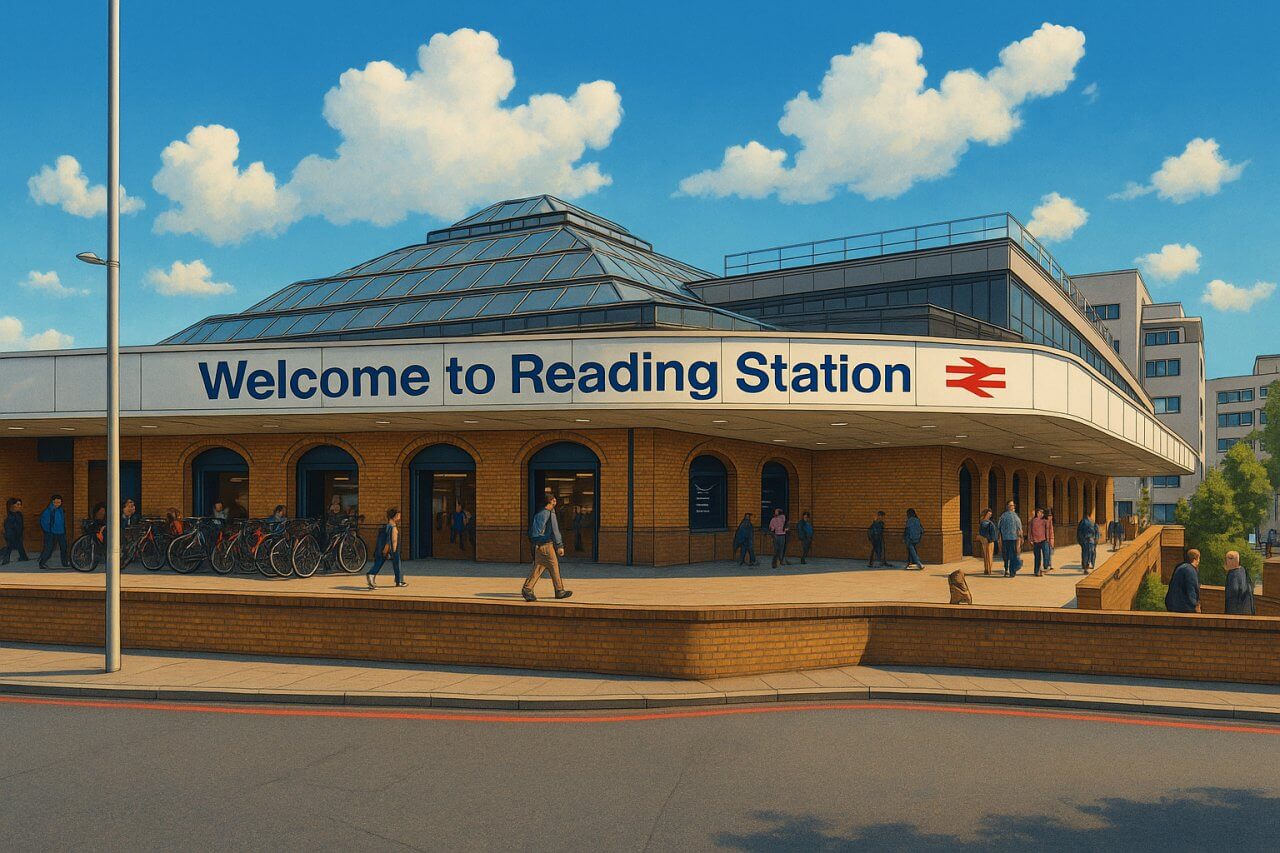
Reading Station
Reading Station, officially known as Reading railway station, serves as the western terminus of the Elizabeth Line. It is a major interchange between London and the Thames Valley region, situated in the Berkshire town of Reading, approximately 37 miles west of Charing Cross by road.
Location and Entrances
Reading Station is centrally located in Reading on Station Approach, which connects to Forbury Road and Blagrave Street. The main station building is situated on Station Hill, which leads to Broad Street, one of Reading’s key shopping thoroughfares. The modern ground-level station building features a large concourse with ticket offices, shops, eateries, and waiting areas, and it also functions as a hub for local buses and taxis.
Rail and Underground Services
Reading Station is a National Rail facility and does not serve the London Underground network directly. However, it is connected to the Elizabeth Line, offering fast and frequent services into central London and beyond. The Elizabeth Line connects Reading with major stations such as Paddington, Tottenham Court Road, and Canary Wharf, ultimately reaching Abbey Wood and Shenfield in the east.
While Reading is not classified among London Underground Stations, its integration with the Elizabeth Line means that passengers can easily access Underground services at interchange stations like Paddington, which connects to the Bakerloo Line, Circle Line, District Line, and Hammersmith & City Line.
Preceding and Subsequent Stations
On the Elizabeth Line, Reading is the terminus at the western end. The next station eastbound is Twyford, followed by Maidenhead and Slough. Trains from Reading travel directly into the heart of London without needing to change, connecting efficiently with lines such as the Northern Line, Central Line, Jubilee Line, and more via interchanges.
History and Development
The original Reading Station opened on 30 March 1840, built by the Great Western Railway (GWR) and designed by the renowned engineer Isambard Kingdom Brunel. It was one of the earliest stations on the line from London to Bristol. The station has since undergone numerous expansions and renovations, the most significant being the major redevelopment completed in 2014, which included a new concourse, platforms, and a pedestrian bridge across the tracks to ease congestion.
Elizabeth Line Integration
The Elizabeth Line service to Reading began on 15 December 2019, marking a major milestone in the development of London’s modern rail infrastructure. The extension of the line to Reading was part of the Crossrail project, aiming to improve travel times and connectivity between London and the southeast of England.
Origin of the Name
The station takes its name from the town of Reading, which itself is believed to derive from the Anglo-Saxon tribe known as the Readingas, meaning "people of Reada"—a tribal leader whose name meant "the red one". The name “Reading Station” has been in use since its opening and has never been officially renamed, though it is sometimes referred to simply as “Reading” by locals and on National Rail signage.
Pronunciation: The name Reading in Reading Station is pronounced like "REDD-ing", not like the verb reading a book. The correct pronunciation is /ˈrɛdɪŋ/  in the International Phonetic Alphabet (IPA). This pronunciation reflects the town's historic name, which comes from the Anglo-Saxon tribe known as the Readingas.
in the International Phonetic Alphabet (IPA). This pronunciation reflects the town's historic name, which comes from the Anglo-Saxon tribe known as the Readingas.
Fun Fact
Reading Station was once the busiest railway junction in the UK outside London. It was also one of the first major British railway stations to install an escalator, long before such amenities became standard at regional stations. Another notable feature is its footbridge, which was designed to allow public pedestrian access between the north and south sides of Reading without needing to pass through the ticket barriers—a unique feature among major UK stations.
Quick Facts
- Location: Station Hill, Reading, Berkshire
- Nearest London terminus: Paddington (via Elizabeth Line)
- Distance from Charing Cross: Approx. 37 miles (60 km) by road
- Lines Served: Elizabeth Line, National Rail (Great Western Railway, South Western Railway, CrossCountry)
- Elizabeth Line status: Western terminus
- Next station eastbound: Twyford
- Opened: 30 March 1840
- Architect/Engineer: Isambard Kingdom Brunel (original station)
- Recent renovations: Major redevelopment completed in 2014
- Named after: The town of Reading; derived from Anglo-Saxon "Readingas"
- Fun fact: One of the first UK stations with an escalator; unique pedestrian footbridge
Reading Station is  on the Map of London Underground
on the Map of London Underground

Painting of Reading Station (View image in full size)